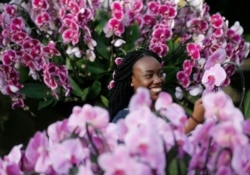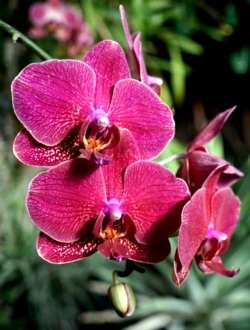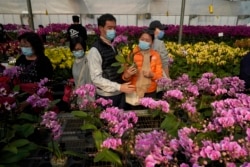From VOA Learning English, this is the Health & Lifestyle report.
Not so long ago, orchids were considered rare and exotic flowers – difficult to find and difficult to grow. But these days, thanks to new growing methods, some kinds of orchids are available in many parts of the world.
Marc Hachadourian is an orchid expert at the New York Botanical Garden. He said orchids are now “the most popular blooming florist crop in the world.” A florist is a person who sells flowers.
Hachadourian recently told the Associated Press that orchids are not only beautiful, but they are good to grow at home.
The blooms are long-lasting. Orchid flowers can last for weeks. Orchids offer an easy, low-cost way to brighten up a room. The flowers come in many colors.
Once the flowers die, however, many people might want to throw the plant away. But not so fast! You might be able to get that orchid to bloom again.
In fact, helping an orchid to rebloom is a great project to do while at home because of coronavirus restrictions. Just know that the pandemic might be over by the time you succeed.
Kenya Friend-Daniel is an orchid expert at Trader Joe’s, a food store that also sells plants and flowers like orchids.
Once the first flowers are gone, Friend-Daniel suggests cutting the stem off at the base and removing the material the plant is growing in. Then move the plant to a slightly larger pot filled with fresh moss or tree bark.
Friend-Daniel said that, “new growth should start coming from the middle of the plant within three to four months.” It will take 12 months for a fully bloomed flower to show.
Blanche Wagner is another orchid expert. She says that orchids use a lot of energy to produce blooms. “They need a full year,” she added, “to build up enough energy to flower again.”
Wagner works at the Missouri Botanical Garden. Their orchid collection is world-famous and dates back to the late 1800s.
She gives a simple suggestion for those wanting to rebloom an orchid: Note when you bought them. This will help you to re-bloom your flower at the best time.
And remember to care for them when they are not in bloom. The most important time to care for your plants is right after the flowers die, said Hachadourian.
At that time, he said, “make sure they get the best available light, water, and fertilizer to make sure they grow their best before flowering again.”
How warm?
Wild orchids grow in rainforests. So, they do well in warm, wet environments. Morning sun is best, says Kenya Friend-Daniel. But avoid direct sunlight, she warns, which can burn the leaves and the blooms.
The ideal temperature while waiting for new growth is about 29 degrees Celsius. Once there is new growth, keep the temperature between 21 to 24 degrees Celsius.
How much water?
Watering orchids is also tricky. How often you water depends on the material you use to plant the flower and also the temperature.
Friend-Daniel said putting water on the roots every day is best. If the plant is growing in bark you could water it once a week in cooler weather and every four to five days in warmer weather.
However, never let the roots sit in water. This will cause them to rot, and the plant will die.
“Most failures with orchids are because of overwatering," said Hachadourian.
He adds that a small amount of water once or twice a week will keep the plant just wet enough without being over wet.
Fertilizer or not?
You can also fertilize orchids -- but not too much. Too much fertilizer can also kill the roots.
Surprise of new orchid blooms.
If you do get new flowers, you may be in for a surprise. Some growers inject color chemicals into the orchid. This makes them bloom bright blue, yellow, orange, or green. Those colored orchids rebloom white.
Whatever color your new blooms are, Hachadourian said the “take-home message” is a good one: “People are reblooming their orchids more than once.”
So, maybe it is good time to grow your own. But Friend-Daniel reminds us that orchids are complex. “No one said it was easy,” she said. “It’s work.”
But the results may be worth it.
And that’s the Health & Lifestyle report. I’m Anna Matteo.
Beth Harpaz reported this story for the Associated Press. Anna Matteo adapted it for VOA Learning English. Mario Ritter, Jr. was the editor.
____________________________________________________________
Words in This Story
exotic stem –adj. from another part of the world
bloom -v. to produce a flower
stem –n. the long thin part of a plant that supports leaves and flowers
moss –n. a kind of green plant with very small leaves that grows on the ground or on trees
bark –n. the outer skin of a tree
rot –v. to slowly break down or decay












